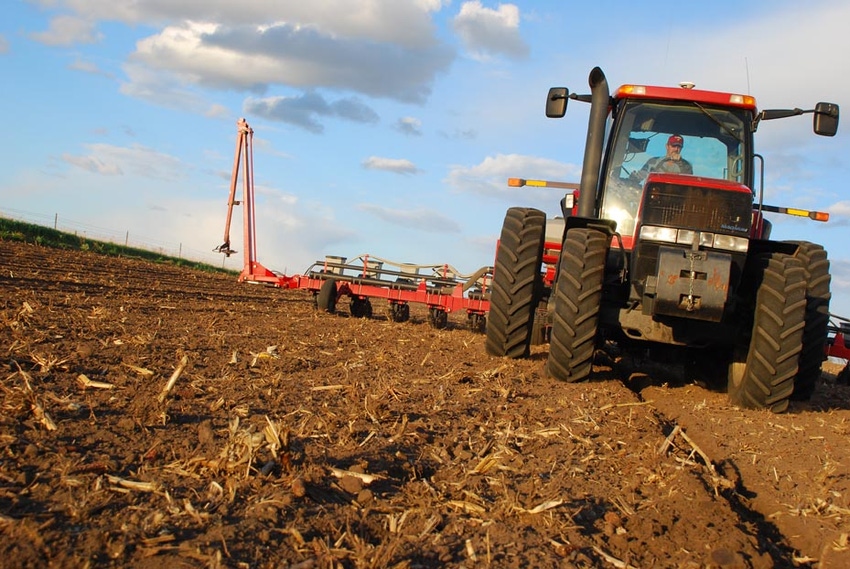April 10, 2017

Like the start of a big race, or the beginning of a championship game, farmers in southern Minnesota and northern Iowa are likely to begin the initiation of full-scale field work during the next week or so, weather permitting. April 11 is the earliest corn planting date allowed by the USDA Risk Management Agency (RMA) in order to maintain full crop insurance replant coverage, and for producers to have full crop insurance coverage for the 2017 corn crop. Any corn that is planted prior to that date is not eligible for replant coverage; however, if the crop is damaged by frost, heavy rains, or hail during the growing season, the crop would still be insured with other crop insurance coverage. The earliest planting date for soybeans in Minnesota and Iowa is April 21.
Soil conditions this spring have been described as “fit for corn planting” by farm operators and agronomists in many areas southern and western Minnesota; however, wet soil conditions still exist in some portions of south-central Minnesota. Assuming we avoid significant amounts of precipitation in the next couple of weeks, producers in most of the region should be able to proceed with tillage and planting, without having to with major wet areas of fields. Some producers have already seeded small grain, and canning peas, as well as spring applications of nitrogen fertilizer and livestock manure.
Overall, soil temperatures have remained cooler than desirable for the initiation of corn planting in the Upper Midwest; however, soil temperatures did warm up rapidly this past weekend, with some above-average temperatures from April 6 to 8. At the University of Minnesota Research and Outreach Center near Waseca, the average soil temperature from April 1 to 6 was about 44° F at the 4-inch level, and 42.5° F at the 8-inch level, which is below the desirable levels for quality corn-planting conditions. These soil temperatures are fairly close to the average long-term average soil temperatures for early April at Waseca, but are slightly above the soil temperatures in early April 2016. A year ago, soil temperatures started warming up in mid-April, and remained at almost ideal levels for the balance of the planting season.
Research shows that 50 percent corn emergence will occur in 20 days at an average soil temperature of 50° F, which is reduced to only 10 days with an average soil temperature of 60° F. In 2016, much of the corn that was planted very early (April 11-15) was very slow to germinate and emerge, as compared to corn that was planted in the last half of April. Most agronomists are encouraging producers to be patient with the initiation of corn planting in 2017, in order to make sure soil conditions are fit before beginning corn planting. There is an increased likelihood of potential frost damage when corn is planted in early April. Every year is different, and producers need to adjust to soil conditions and weather forecasts when making mid-April corn planting decisions.
Most portions of southern Minnesota and northern Iowa are in reasonably good shape for stored soil moisture as we head into the 2017 growing season. The U of M Research Center at Waseca is close to capacity for stored soil moisture entering the 2017 crop year, after receiving above-normal precipitation during fall 2016. Conditions are a bit drier in western half of Minnesota, as well as in the eastern Dakotas; however, most of these areas still have stored soil moisture readings that are average to above average heading into the 2017 growing season. Having adequate soil moisture should not be a problem for corn germination and emergence in most areas of the Upper Midwest. Moderate drought conditions do exist in some areas of the Southern Plains and the Southeast U.S.
Early to the field
2017 is setting up to be the third year in a row of a fairly early start to spring fieldwork in southern Minnesota and Northern Iowa. Early corn planting in the Upper Midwest is usually one of the key factors to achieving optimum corn yields in a given year. But how early is “too early?" University of Minnesota and private seed company research seems to indicate that the ideal planting date for corn in Southern Minnesota is typically from April 15 to May 7. However, the ideal planting date for corn varies somewhat from year-to-year, depending on soil temperatures and soil conditions.
Producers in many portions of the region achieved almost optimum corn and soybean planting dates and conditions in both 2015 and 2016, with only isolated emergence problems. The result was record corn and soybean yields in many portions of the region in both 2015 and 2016. The average or below-average 2016 crop yields in some portions of south-central Minnesota and north-central Iowa were primarily caused by heavy rains and drown-out damage later in the growing season.
Unless conditions turn very wet in the next couple of weeks, a large majority of corn in Minnesota should be planted before the end of April again this year, similar to 2015 and 2016. Historically, early planting of corn usually leads to higher-than-normal state average corn yields. In fact, in six of the eight years that 50% or more of the state’s corn acres have been planted in April, Minnesota has set a record corn yield. Minnesota had record corn yields of 193 bushels per acre in 2016, and 188 bushels per acre in 2015, besting the previous record corn yield of 177 bushels per acre in 2010. One of the years that Minnesota did not have a record yield with the earlier planting dates was in the drought year of 2012; however, Minnesota did have the highest statewide corn yield in the Midwest that year at 165 bushels per acre. The common denominator in these exceptional corn yield years is that in 2010, 2012, 2015, and 2016 a majority of the state’s corn crop was planted by the end of April.
About the Author(s)
You May Also Like






